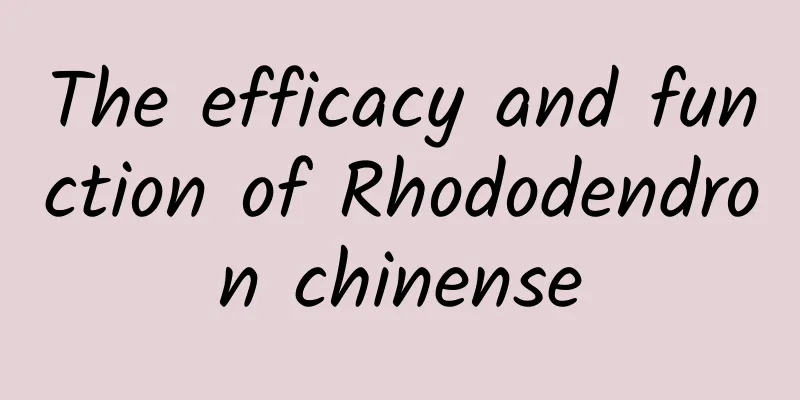The efficacy and function of Northeast Tripterygium wilfordii

|
Northeast Tripterygium wilfordii is a very common medicinal material in life. It can be used to make medicated food and medicine. The usage of Northeast Tripterygium wilfordii is also quite wide, so you can choose it with confidence. Let’s take a look at it together. [Source] Medicinal material source: the root or whole plant of Tripterygium wilfordii of the Celastraceae family. [Original form] Northeast Tripterygium wilfordii is a vine-like shrub, about 2m tall. The branches are brown, the twigs are light reddish brown, often hexagonal, glabrous, and have small warty lenticels. Leaves are alternate; petiole 1-4cm long; leaf blade oblong to obovate, 5-20m long, 3-12cm wide, caudate-pointed or acuminate at the apex, with irregular blunt serrations on the margin, and rounded base. The terminal thyrse is 10-30cm long, the flowers are polygamous, white-green, and about 5mm in diameter; there are 5 sepals; 5 petals; 5 stamens, attached to the outer edge of the shallow cup-shaped disk; the ovary of the bisexual flowers has 3 edges. Capsule with 3 thin membranous wings, 2-1.5 cm long, with wavy edges. The seeds are long columnar and dark red. The flowering period is July-August, and the fruiting period is August-September. [Habitat distribution] Ecological environment: Grown on mountain forest edges, roadsides, on the edge of coniferous or mixed coniferous and broad-leaved forests, or in forests. 【Properties】 Characteristic identification: The stems and branches are cylindrical, with a diameter of 2-6mm. Old branches are gray-brown or brown, with internodes 4-9cm long; the surface has protruding punctate or longitudinal oblong punctate lenticels, with 5-6 longitudinal ridges, leaf scars are raised, alternate, semicircular or nearly kidney-shaped, and there are often buds in the axils, which are ovate-triangular or branched; the branches of the current year are brown or brown-red, and gray-green leaves can sometimes be seen, which are often broken. The intact ones are oblong, ovate or obovate when flattened, 6-15cm long, 3-10cm wide, with a broad cuneate or rounded base, and an acute or long-tailed tip; the petiole is 1-2cm long. The stem is hard and difficult to break. The bark is thin and light brown in cross section, while the xylem is broad and thick, yellowish white. The pith is broad and light brown or nearly white. Slight odor, light taste. 【Chemical composition】 The root contains regelinol, regelide, regelin A, regelin C and D, regelinoliol A and B, regelidine, wilforlide A and B, 3β-hydroxy-olean-11-13(18) diene, orthosphenic acid, salaspermic acid, 3-epikatonic acid, maytenfolic acid, 3β-acetyl-oleanolic acid and celastrol. In addition, six diterpenequinones were isolated from the roots. The stem bark contains tripterregeline A, B, and C. The stem xylem contains wilforlide A, B, β-sitosterol, and dulcitol. The whole plant contains polysaccharides, which are composed of D-glucose, arabinose and galactose. The plant also contains hypolid and trinterolide. [Pharmacological action] Subcutaneous injection of Northeast Tripterygium wilfordii decoction into mice for 5-8 days can cause thymus atrophy, inhibit thymocyte proliferation caused by interleukin 1 (IL-1), weaken the proliferation response of spleen cells to concanavalin A (ConA)-induced T cell proliferation, reduce the ability of spleen cells to produce IL-2, and significantly reduce the percentage of T cells in the spleen. It shows that it has a significant inhibitory effect on cellular immune function. Subcutaneous injection of Northeast Tripterygium wilfordii decoction into mice had an inhibitory effect on the quantitative hemolytic spectrophotometry (QHS) reaction and hemolytic plaque-forming cell (PFC) reaction induced by thymus-dependent (TD) antigens, but had no significant effect on the QHS reaction, PFC reaction induced by thymus-independent (TI) antigens and the B cell proliferation reaction induced by Escherichia coli lipopolysaccharide (LPS). Combined with its inhibitory effect on IL-2 production by mouse spleen cells, it shows that Northeast Tripterygium wilfordii has no obvious direct inhibitory effect on B cell function. Its inhibitory effect on humoral immunity is through inhibiting the production of TH cells. For the experimental arthritis model of rats induced by type II collagen extracted from fetal cartilage, subcutaneous injection of a decoction of Northeast Tripterygium wilfordii can reduce the severity of arthritis lesions, delay the onset of the disease, and reduce the IgM concentration of the model animals. In vitro, it inhibits the proliferation response of rat blood mononuclear cells induced by ConA and the activity of mononuclear cells to produce IL-2, but has no obvious inhibitory effect on the proliferation response of rat blood mononuclear cells induced by LPS. 【Nature and flavor】 Bitter; pungent; cool; poisonous 【Meridian】 Liver; Gallbladder; Spleen 【Functions and indications】 Dispel wind and dampness; promote diuresis and reduce swelling; kill insects and detoxify. Mainly used for rheumatoid arthritis; swelling and edema; jaundice; abdominal mass; traumatic injury; scrofula; sores, swelling and pain; tinea capitis; skin itching; snake bites [Usage and Dosage] For oral use: decocted in water, 1-6g. For external use: take appropriate amount, grind into powder and apply; or mash it and apply; or mash it into juice and apply. 【Note】 Use with caution when taking orally, and external application time should not exceed 30 minutes. "Changbai Mountain Plant Medicinal Records": "It should be taken with caution when taken internally." 【Excerpt】 Chinese Materia Medica The above is a brief introduction to the medicinal value of Northeast Tripterygium wilfordii. For most people in real life, there is no need to worry about side effects when using Northeast Tripterygium wilfordii to treat diseases. Therefore, the treatment of diseases with Northeast Tripterygium wilfordii is an effective and practical treatment method, and it has been widely used in clinical practice. |
<<: Effects and functions of Northeast Alnus
>>: The efficacy and function of wax gourd leaves
Recommend
What diseases can natural pine pollen cure
Pine pollen is the pollen of the stamens on the p...
What is the medicinal value of tung flowers?
I believe many of my friends don’t know about tun...
The role and efficacy of mulberry
I believe everyone has eaten mulberries. Every wi...
Winter mood "collapse"? Don't panic, these tips will help you see the sun again!
Every winter, many people often feel as if their ...
China will launch the "Einstein Probe Satellite" to survey and locate black holes in the universe
Recently, the Chinese Academy of Sciences announc...
The efficacy and function of blue sky grass
Speaking of blue sky grass, I believe many friend...
Unbelievable! First discovery of Antarctic snow…
Researchers have discovered microplastics for the...
The efficacy and function of chestnut
Everyone is familiar with stone chestnut, of cour...
State Post Bureau: The total delivery time for express delivery services in Q2 2023 is 53.99 hours, and SF Express ranks first in public satisfaction
Recently, the State Post Bureau released the resu...
How can we avoid risks in the face of heavy rain or even floods?
Affected by the northward movement of the remnant...
The efficacy and function of hedgehog skin
There are many types of Chinese medicine. When we...
In this hottest season for weight loss, how many people have been deceived by the "low-carb diet"?
Audit expert: Wang Guoyi Postdoctoral fellow in N...
The efficacy and function of wild sorghum
As a traditional Chinese medicinal material, do y...
What are the therapeutic and health benefits of massage acupuncture devices
If Western medicine is used to treat some disease...
[Creative Incubation Program] Is the plot of "Jurassic World" realistic? Can we resurrect dinosaurs?
Author: Liu Sen Recently, Jurassic World 3 was re...









